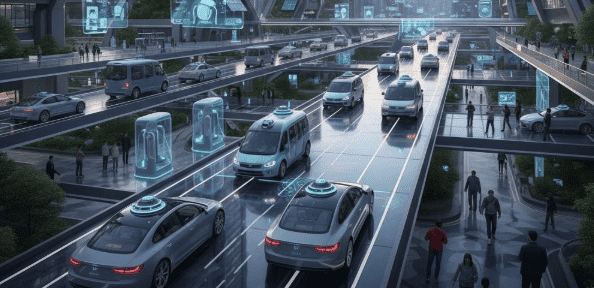As autonomous vehicles are forging into a new auto realm of transportation, a U. S. realm is slowly being opened. The idea of a safer vehicle working in tandem with fewer cars on the road to improve mobility is tantalizing. Here, we will discuss new advances in autonomous vehicles, their benefits, challenges, and how they help with a smarter and efficient America.
What Are Autonomous Vehicles?
Autonomous vehicles (AVs), or self-driving cars, use sensors, cameras, and artificial intelligence (AI) software to navigate roads without human interference. Manufacturers design these vehicles to operate in various modes—from fully driverless to semi-autonomous or driver-assisted systems like lane-keeping, adaptive cruise control, and manual braking.
Moreover, the adoption of autonomous vehicles is rapidly accelerating across America, driven by technological innovations, supported by government policies, and reinforced by growing consumer interest in safer and more efficient transportation.
Key Drivers of Autonomous Vehicle Adoption in the USA
Currently, several key factors are actively contributing to the rapid rise of autonomous vehicles in the United States.
- Technological Advancements
Innovations in AI, machine learning, sensor technology, and 5G improve the performance of autonomous vehicles. They enable these vehicles to detect obstacles, analyze traffic patterns, and make real-time decisions. As a result, they greatly reduce human error and make streets much safer for everyone.
- Safety Concerns
Road accidents have remained a dreadful issue in the USA, claiming thousands of lives each year due to human error. Autonomous vehicles, however, might drastically decrease accidents through AI-based decision-making, thus ensuring safer roads for drivers, passengers, and pedestrians.
- Government Support and Regulations
The federal government is putting in efforts and providing funding for AV research and development with pilot projects and rulemaking. States such as California, Arizona, and Michigan have also passed laws to support autonomous vehicle testing and deployment. Thus, innovations and technological growth will have a fertile field to take root and flourish.
- Consumer Demand for Convenience
Whatever the consumers of the US might appreciate, there is more and more a greater need for convenience and time-efficiency in transportation. This makes travel by driverless vehicles attractive due to the essence of giving hands-free driving, stress reduction, and choosing the best commute. Having this feature, high-class urban populations, with their busy lifestyle, have great appeal for it.

Check out Other Top Innovations in the USA for Autonomous Vehicles
Moreover, the autonomous vehicle realm is rapidly evolving, with several innovations emerging and new trends leading the way.
- Fully Autonomous Cars
Waymo, Tesla, and Cruise are developing fully autonomous car systems that operate without any human control. These companies use LiDAR, radar, and cameras powered by AI-based algorithms to manage communication, navigate urban areas, and drive safely on highways. Over time, these systems continuously learn and refine their performance to become even more efficient and reliable.
- Semi-Autonomous Features
Many modern vehicles offer semi-autonomous features such as adaptive cruise control, lane departure warnings, and automated parking. These systems enhance safety, ease driving tasks, and reduce driver stress.
- Autonomous Public Transit
Currently, autonomous buses and shuttles are being tested in various U.S. cities to improve public transport efficiency. For example, driverless shuttles in Las Vegas and Phoenix help alleviate traffic congestion, while also providing safe and reliable mobility options for both residents and visitors.
- Delivery and Logistics Automation
In the logistics marketplace, autonomous vehicles are being embraced for efficient deliveries. They want to use self-driving delivery vans and drones. By doing so, they aim to optimize last-mile delivery, reduce costs, and minimize environmental impact.
- Advanced AI and Connectivity
Given that autonomous vehicles are primarily dependent on AI and V2X communications, this allows the vehicles to interface with traffic signals, other vehicles, and the infrastructure. Hence, the real-time decisions improve, and traffic flows are optimized; collisions become rarer events.
Advantages of Autonomous Vehicles
Indeed, the deployment of autonomous vehicles in the United States brings several remarkable advantages:
- Enhanced Safety: Fewer accidents are occurring due to human errors.
- Improved Traffic Flow: Optimizing routing mechanisms reduces congestion and commuting time.
- Environmental Impact: Electric autonomous vehicles that emit fewer emissions can be considered cleaner transportation.
- Accessibility: Providing a solution for moving around for the elderly, disabled, and non-drivers.
- Economic Growth: Emerging careers in AI, robotics, manufacturing, and infrastructure development.
Challenges to the Autonomous Vehicle Adoption
Considering autonomous vehicles still have a bright future, in the United States, the absence of infrastructure technologies will pose some challenges:
- Roadblocks: Implementation is hindered by complex federal and state regulations.
- High Costs: Expenses for advanced sensors, AI systems, and developmental work on vehicles are still very high.
- Public Trust: Many of the end-users are unwilling to fully entrust self-driving technology.
- Cybersecurity Risks: Vehicle connectivity permits hacking and data breaches.
- Infrastructure Needs: Roads, traffic signals, and urban layouts must be upgraded for AV technology.
Therefore, accepting the onus of addressing these challenges associated with the spread of automated vehicles inevitably lies jointly with manufacturers, tech companies, and governmental bodies.
The Future of Autonomous Vehicles in the USA
The future of autonomous vehicles in the USA looks very bright. It is predicted that until 2030, self-driven cars will form a sizeable chunk of the U. S. vehicle market. With technological advancements in AI, more test runs, and greater acceptance by the population, autonomous vehicles will most probably become a normal sight on American roadways.
In addition, the very existence of smart city infrastructure along with autonomous vehicles will assure better traffic management, emission reduction, and another seamless urban mobility experience. As a result, industries such as logistics, ride-sharing, and transit shall re-engineer themselves for a win-win first economically and then environmentally.
How Businesses Can Utilize Autonomous Vehicles
In the USA, businesses can also take full advantage of autonomous vehicle technology in several ways:
- Fleet Automation: Autonomous trucks or delivery vans can help companies reduce operational costs and improve efficiency.
- Ride-Sharing Services: Autonomous vehicles can provide more ride-hailing options at affordable prices and safer rides.
- Smart Logistics: Autonomous technology can help businesses optimize supply chains and last-mile delivery.
- Collaborations Yield Innovations: Connect with AV startups to fast-track the adoption of cutting-edge solutions.
- Sustainability Initiatives: Electric autonomous fleets allow companies to meet their sustainability goals and reduce carbon footprints.
Conclusion
Autonomous vehicles are set to transform transportation in the USA, offering mobility solutions that are safer, greener, and more efficient. Self-driving vehicles and semi-autonomous vehicle features, public transportation, and logistics are revolutionizing how Americans travel, work, and live.
Technology advancements, government policy changes, and the growth of public trust from today onward will see autonomous vehicles steadily assuming a bigger role in realizing a smarter, safer, and more sustainable America. Businesses, as well as consumers, who take pride in these advanced technologies will claim their lion’s share in the next revolution in transportation.
To put more investment into the autonomous vehicle technology would not just be a choice of technology, but an investment into a safer, greener, and interconnected future.
